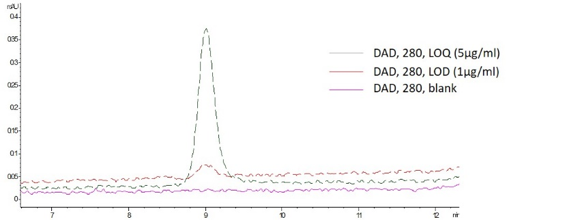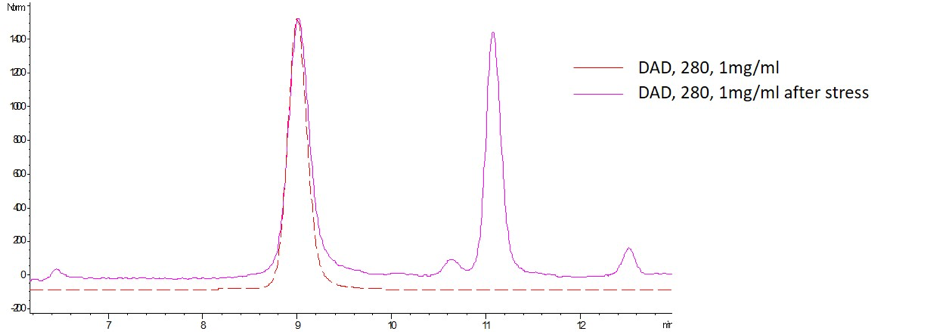Introduction
Therapeutic proteins are subject to aggregates and degradation phenomena throughout their development phases, such as expression, treatment, purification, and storage. Even if aggregates and degradation products are present at very low levels compared to the drug one it could have significant consequences on biological product, on solubility or activity for example.
Characterization and monitoring of such drug product modifications could be necessary either to select the best drug candidates or to evaluate its best storage conditions. Steric exclusion chromatography is currently the standard method used to characterized protein aggregates.
in this example, we deployed SEC approach to assess modifications induced by stress conditions on a therapeutic mAb.
Method evaluation
Monoclonal antibody calibration range was done between 1µg/ml and 1mg/ml and the lower detection limit and quantitation limit were evaluated using SEC chromatography in aqueous conditions.
The lower detection limit (LOD) and quantitation limit (LOQ) by SEC analysis were respectively 1µg/ml and 5µg/ml for the studied mAb. Figure 1 demonstrates the overlaid chromatograms for the blank and mAb samples at LOD and LOQ.

Figure 1: mAb LOD and LOQ chromatograms overlaid with blank
Calibration curves for the studied mAb were performed by integrating chromatographic peak area for each mAb concentration. Area results are presented in the following table. The 3-logs obtained calibration curve (from 1 to 1000 µg/ml) is represented in the Figure 2.

Table 1 : Calibration curve results

Figure 2: Left, calibration range of therapeutic mAb in solvent; Right, overlaided chromatograms of all mAbs concentration points
This analytical method shows a great reproducibility and linearity to analyse monoclonal antibodies and their possible degradation. This method could also be used to quantify monoclonal antibodies and to compare production batches.
Monoclonal antibody degradation analysis
In order to stress monoclonal antibody, the pH variation was implemented from 1 to 10 using HCl 1M and NaOH 1N prior to bring it back to the initial value. Then pH stressed mAb was also incubated 30 minutes at 30°C.
Comparison between native therapeutic mAb and stressed therapeutic mAb using steric exclusion chromatography allows to control the emergence of aggregates and degradation products. Chromatographic peaks eluated before the mAbs monomer form are considered as mAb aggregate whereas chromatographic peaks eluated after are considered as mAb degradated form. Figure 3 represents the normalized chromatograms obtained for mAb before and after stress treatment.

Figure 3: Native mAb and stressed mAb chromatograms
To go further, a relative quantitation of aggregates and degradation product was made, based on area percentage. Results are represented in the table 2.

Those results demonstrate a significant decrease of mAb monomer form, from 99% to 42% due to pH and heating stress conditions. Also, apparition of aggregation form and especially degradation are clearly put forward. These results confirm that stress condition have a significant impact on the mAb integrity, and that SEC approach is well adapted to detect these modifications.
Concluding remarks
SEC appears to be a method of choice to evaluate mAb integrity and monitor its stability. To go further in the exploration way, results has to be completed by mAb biological activity analysis, while mAb integrity could be checked by more resolutive approach such as mass spectrometry, in order to verify that Cter or Nter amino acids were not deleted. This resolutive power is not possible with SEC approach.
 Anaquant HCP analysis I Protein characterisation I Protein analysis
Anaquant HCP analysis I Protein characterisation I Protein analysis